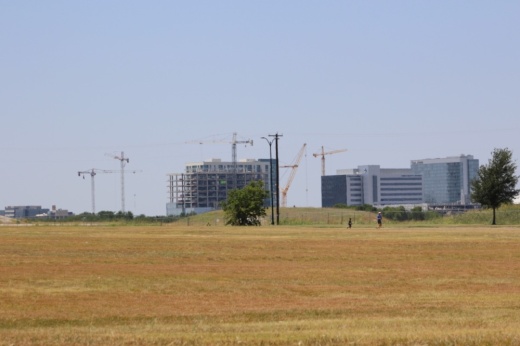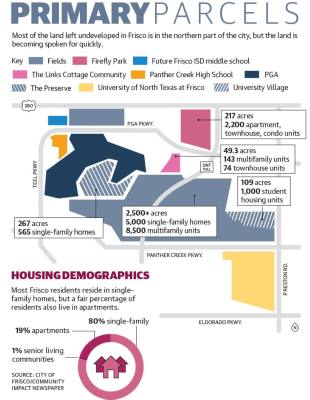About 75% of Frisco is built out or claimed at this point, Frisco’s Development Services Director John Lettelleir said. That includes projects in the northern part of the city, such as the Professional Golfers Association of America headquarters development, the Fields community and the Firefly Park mixed-use project.
“Anything that’s in the quadrant that’s north of Panther Creek along the Dallas Parkway is going to add a lot [of value to the city] because of the amount of vacant land there,” Lettelleir said.
This section is one of the final frontier areas in the growing city of Frisco. About 20 years ago, Frisco was about 40% built out, Lettelleir said. City planners are now looking at how to best develop its last remaining portions of land, with about 9,000 acres to explore, according to a report from the development services department.
Jenny Dowdy, Keller Williams Realtor and owner of Jenny Knows Real Estate, said as Frisco approaches build-out, home values in the area are significantly increasing as demand for the remaining space builds.
“Frisco is going to become a destination, just like other principal cities in and around the United States are becoming destinations, and you pay for that privilege,” Dowdy said.
Projects in the works
Several projects are taking shape in the northern part of Frisco. Among these are the Fields development, which will include 5,000 single-family homes, 8,500 apartment units and 1,000 units of student housing. The student housing will help serve The University of North Texas at Frisco campus coming to Preston Road on the city’s north side.
Adjacent to the Fields project and the PGA Frisco headquarters is The Link, a nearly 240-acre project that will include luxury residential. Closer to the Dallas North Tollway is a new, 217-acre mixed-use project called Firefly Park that comes with luxury hotels, offices and residences for sale and for lease. Frisco’s growth travels along a corridor, Lettelleir said. It comes out of Dallas and travels along Dallas Parkway and Preston Road. As these parcels develop, utilities along this corridor are extended, which in turn attracts more developments, he said.
“It falls back on infrastructure,” he said. “The northern tracts are starting to develop because the roadways are getting put in.”
Kyle Wilks, president of Wilks Development, the team behind Firefly Park, said it was important that residents and employees in the park have access to major roads, such as the Dallas North Tollway. That is part of what attracted him to the 200-plus acres this project will use, he said.
“Everybody kind of knows development is moving up the tollway,” Wilks said. “Frisco doesn’t have a lot of acres left ... and as we have all seen, Frisco develops pretty quickly.”
In mid-June, Baylor Scott & White Health requested to rezone about 47 acres on the northeast corner of Dallas Parkway and PGA Parkway, taking up another piece of Frisco.
“We are constantly evaluating ways to expand access to care for Texans, especially in our fastest-growing communities,” Baylor Scott & White Health officials said in a statement.
One outlier to the trend of northern development is the Brinkmann Ranch property. This property is located in the heart of Frisco, along Preston Road and Main Street. Builders with Landon Homes are turning 103 acres of the fields there into a new subdivision called Lexington Parks. The model homes for the project opened in late May, and the first residents are expected to live in the community at the end of July, a spokesperson for Landon Homes said.
Once land is zoned, it stays that way unless it comes back for rezoning, Lettelleir said. With that in mind, the city is intentional about how the last large portions of Frisco change to maintain the city’s ad valorem taxes.
“At the end of the day, what gets developed on the land has a huge impact on the city’s financial bottom line,” Lettelleir said.
Growing demand for housing
The development is translating to higher home values, Dowdy said, especially as the city adds to the services that make it attractive to residents.
In the last five years, the median sales price of a home in Frisco has increased more than 72%, according to data from the Collin County Association of Realtors. In May, the median home price in Frisco was $725,000, but Dowdy said that could change.
“Indications have told us that we’re going to see a slowdown a little bit, maybe a value adjustment, but it’s still going to continue to [rise in] value,” Dowdy said.
The types of people who want to move to Frisco vary, she said. But the main driver bringing people to Frisco is the school system, Dowdy said. Many families moving in for the school district seek out older Frisco neighborhoods where it is still possible to find homes under $500,000, she said.
Frisco ISD is still experiencing the effects of being part of a rapidly growing city. While the district has slowed its growth from where it was six or seven years ago, it is still adding students each year, FISD Deputy Superintendent Todd Fouche said. The school district serves about 66,000 students across 73 campuses. And more campuses are needed, Fouche said.
The district has several school campus projects in the works, with three in the northern part of Frisco where so much other development is happening. Those will act as reliever campuses for the existing schools while also being built with room to take on additional students, he said.
“We need to meet the needs of those residents who are in that area,” Fouche said. “But then also, we know that area is exploding right now.”
Ripe for redevelopment
While new developments come into the city, other parts of Frisco are going under major construction for redevelopment.
Known as a business hub with more than 2.5 million square feet of Class-A office space, Hall Park at the southern end of Frisco is being redeveloped to become a mixed-use entertainment district. This includes space for an upcoming Performing Arts Center with a parking garage and a 5-acre park. The area was also rezoned to allow for apartments.
Additionally, the city is focusing efforts on redeveloping its downtown corridor so pedestrians can have easier access to the things to do and see in downtown. That includes plans to reconstruct the streetscapes and to install a pedestrian plaza.
Maintaining the developed portions of Frisco is crucial and also means a city is never truly built out, according to Lettelleir. He said a successful city needs three things: a good school district, the kinds of services people do not have to go elsewhere for and aesthetics.
“If we can have a city that people say, ‘Hey, I’ve got all these three things, I’m going to stay in Frisco,’ that leads to potentially increasing where people reinvest in their homes and keep property values up,” Lettelleir said.
Dowdy pointed out that major events coming to the Dallas area, such as the 2026 FIFA World Cup—one of the world’s largest sporting events—as well as the upcoming PGA Championship tournament in 2027, are going to continue to draw residents to Frisco. More residents are also going to come as Frisco’s projects take shape to transform the field land and redevelop existing structures. But these residents are going to have to pay more to live in the area.
“Frisco is a shining star now, but we don’t want it to lose its luster as it ages,” Lettelleir said. “That happens through thoughtful redevelopment, but that also takes teamwork and working with developers and property owners.”






